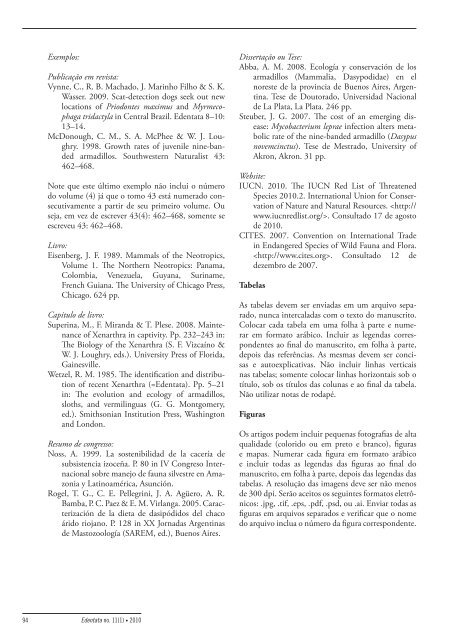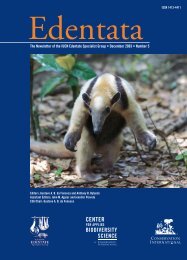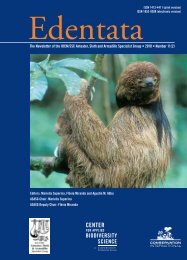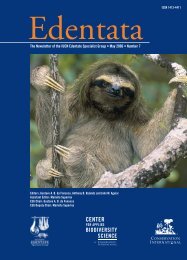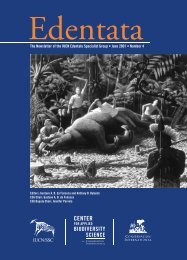Edentata 11(1) - Anteater, Sloth & Armadillo Specialist Group
Edentata 11(1) - Anteater, Sloth & Armadillo Specialist Group
Edentata 11(1) - Anteater, Sloth & Armadillo Specialist Group
Create successful ePaper yourself
Turn your PDF publications into a flip-book with our unique Google optimized e-Paper software.
Exemplos:<br />
Publicação em revista:<br />
Vynne, C., R. B. Machado, J. Marinho Filho & S. K.<br />
Wasser. 2009. Scat-detection dogs seek out new<br />
locations of Priodontes maximus and Myrmecophaga<br />
tridactyla in Central Brazil. <strong>Edentata</strong> 8–10:<br />
13–14.<br />
McDonough, C. M., S. A. McPhee & W. J. Loughry.<br />
1998. Growth rates of juvenile nine-banded<br />
armadillos. Southwestern Naturalist 43:<br />
462–468.<br />
Note que este último exemplo não inclui o número<br />
do volume (4) já que o tomo 43 está numerado consecutivamente<br />
a partir de seu primeiro volume. Ou<br />
seja, em vez de escrever 43(4): 462–468, somente se<br />
escreveu 43: 462–468.<br />
Livro:<br />
Eisenberg, J. F. 1989. Mammals of the Neotropics,<br />
Volume 1. The Northern Neotropics: Panama,<br />
Colombia, Venezuela, Guyana, Suriname,<br />
French Guiana. The University of Chicago Press,<br />
Chicago. 624 pp.<br />
Capítulo de livro:<br />
Superina, M., F. Miranda & T. Plese. 2008. Maintenance<br />
of Xenarthra in captivity. Pp. 232–243 in:<br />
The Biology of the Xenarthra (S. F. Vizcaíno &<br />
W. J. Loughry, eds.). University Press of Florida,<br />
Gainesville.<br />
Wetzel, R. M. 1985. The identification and distribution<br />
of recent Xenarthra (=<strong>Edentata</strong>). Pp. 5–21<br />
in: The evolution and ecology of armadillos,<br />
sloths, and vermilinguas (G. G. Montgomery,<br />
ed.). Smithsonian Institution Press, Washington<br />
and London.<br />
Resumo de congresso:<br />
Noss, A. 1999. La sostenibilidad de la cacería de<br />
subsistencia izoceña. P. 80 in IV Congreso Internacional<br />
sobre manejo de fauna silvestre en Amazonia<br />
y Latinoamérica, Asunción.<br />
Rogel, T. G., C. E. Pellegrini, J. A. Agüero, A. R.<br />
Bamba, P. C. Paez & E. M. Virlanga. 2005. Caracterización<br />
de la dieta de dasipódidos del chaco<br />
árido riojano. P. 128 in XX Jornadas Argentinas<br />
de Mastozoología (SAREM, ed.), Buenos Aires.<br />
Dissertação ou Tese:<br />
Abba, A. M. 2008. Ecología y conservación de los<br />
armadillos (Mammalia, Dasypodidae) en el<br />
noreste de la provincia de Buenos Aires, Argentina.<br />
Tese de Doutorado, Universidad Nacional<br />
de La Plata, La Plata. 246 pp.<br />
Steuber, J. G. 2007. The cost of an emerging disease:<br />
Mycobacterium leprae infection alters metabolic<br />
rate of the nine-banded armadillo (Dasypus<br />
novemcinctus). Tese de Mestrado, University of<br />
Akron, Akron. 31 pp.<br />
Website:<br />
IUCN. 2010. The IUCN Red List of Threatened<br />
Species 2010.2. International Union for Conservation<br />
of Nature and Natural Resources. . Consultado 17 de agosto<br />
de 2010.<br />
CITES. 2007. Convention on International Trade<br />
in Endangered Species of Wild Fauna and Flora.<br />
. Consultado 12 de<br />
dezembro de 2007.<br />
Tabelas<br />
As tabelas devem ser enviadas em um arquivo separado,<br />
nunca intercaladas com o texto do manuscrito.<br />
Colocar cada tabela em uma folha à parte e numerar<br />
em formato arábico. Incluir as legendas correspondentes<br />
ao final do manuscrito, em folha à parte,<br />
depois das referências. As mesmas devem ser concisas<br />
e autoexplicativas. Não incluir linhas verticais<br />
nas tabelas; somente colocar linhas horizontais sob o<br />
título, sob os títulos das colunas e ao final da tabela.<br />
Não utilizar notas de rodapé.<br />
Figuras<br />
Os artigos podem incluir pequenas fotografias de alta<br />
qualidade (colorido ou em preto e branco), figuras<br />
e mapas. Numerar cada figura em formato arábico<br />
e incluir todas as legendas das figuras ao final do<br />
manuscrito, em folha à parte, depois das legendas das<br />
tabelas. A resolução das imagens deve ser não menos<br />
de 300 dpi. Serão aceitos os seguintes formatos eletrônicos:<br />
.jpg, .tif, .eps, .pdf, .psd, ou .ai. Enviar todas as<br />
figuras em arquivos separados e verificar que o nome<br />
do arquivo inclua o número da figura correspondente.<br />
94<br />
<strong>Edentata</strong> no. <strong>11</strong>(1) • 2010


